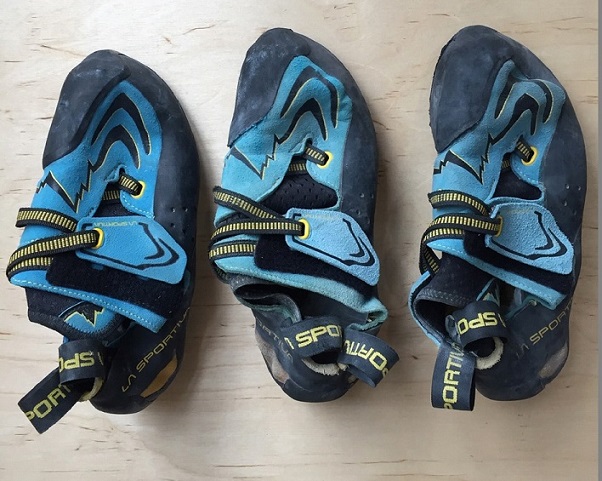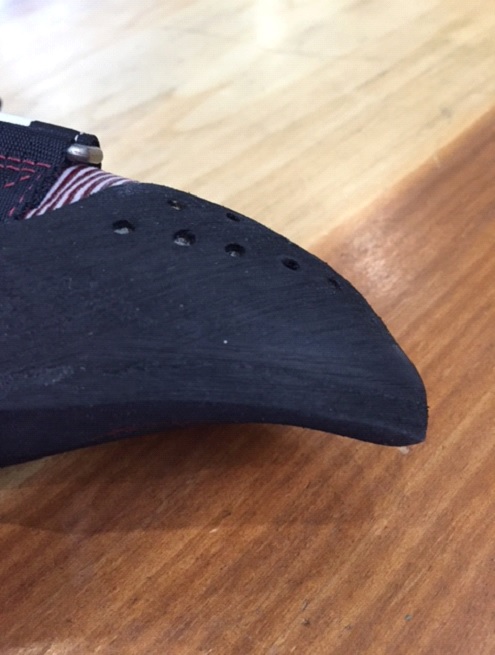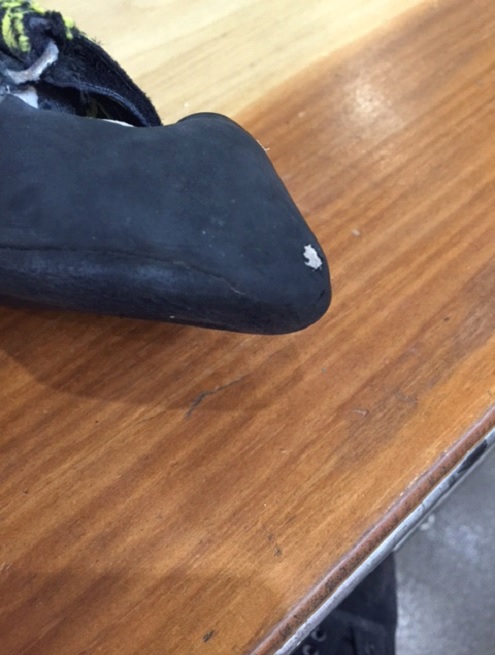Climbing shoes: buying and selling, used and new

Maybe you've just started climbing and you're breaking in your first pair of climbing shoes in the gym. Or maybe you've been climbing for 10 years and have a closet full of climbing shoes, skipping Goldilocks-like between pairs because this one is too cambered, but this one is too insensitive on polished slabs. Either way, one day you'll reach a time with your shoes when they are, to use technical terms, "shot." But what does that mean? How shot is too shot? Should you get them resoled? Or surely someone will want to use them if you bring them to the Annex and ask for a bargain-basement price, right? Identifying the wear and tear of your climbing shoes will enable you to make the right decisions about using, resoling, or getting rid of them. Also, not only can you assess your own shoes, you'll be able to buy used shoes and know what quality shoe you're getting every time.
Buying used climbing shoes is a lot like buying new climbing shoes: it all comes down to fit and feel. Take your time and try on as many different pairs as you can find near your size, bearing in mind that shoes fit differently across brands and models. A well-fitting climbing shoe should have no dead spaces or wiggle room, but there should be no hot spots, pinching, or pain. Remember that used shoes have been broken in by feet that aren't yours, and that might contribute to a different feel. Look for shoes that are snug and seem to exhale their air for a vacuum-like seal when you pull them on.
When determining if a shoe is "shot," first give an overall look at the parts of the shoe from the rand up. If the shoe has velcro straps, like the one pictured below, look them to see if they are fuzzy, torn, or otherwise blown out. Look especially at where the velcro folds around the buckle! If it has laces, check the eyelets, the aglets, and the laces themselves to see if they are worn, torn, fuzzy, or frayed. Laces can be replaced, but be sure to factor that cost in. The pull straps should be fully secured to the shoe, not ripping off. Most climbing shoe uppers are made of leather or synthetic leather, so check that for signs of age and wear. Leather can stiffen, or start to pull away from the rand. Finally, check that the heel cup has retained its shape and isn't collapsed or spongy. All of these factors will affect the fit and feel of the shoe on your foot, but you'll have to look at the rubber to assess how the shoe will perform.

Image from New England reSoul
The shoe's sole and rand are both made of rubber, but they function differently. The rand is a thin layer of rubber that wraps around the upper, and goes underneath the sole on the bottom of the shoe. It protects the material of the upper, attaches the sole to the shoe, and also provides friction for toe-hooking and heel-hooking. The sole is a thicker layer of sticky rubber that provides the foot's point of contact with the rock. The sole (specifically, the toe) is what will likely wear out first on your shoes.
Here are some examples of wear on shoes we have at the Annex.

Here is the toe from a new pair of shoes here at the Annex. You can see a clear line between the sole and the rand, the rubber on the toe is sharp, and the edge is straight and clean. The only concern with buying and wearing them would be breaking them in. Otherwise, you can expect a shoe like this to last as long as any brand new shoe does for you. If your existing shoes look like this, the only reason to resell them would be because they don't fit well or feel right on your feet.

Unlike the previous pair, these shoes have obvious wear. The line between the rand and the sole is wavy and chewed-looking, and the rubber is starting to wear thin from contact with rock or climbing walls. A climber could expect about half as much wear time out of these shoes as-is; resoling them would provide additional wear time. If your shoes look like this, now—while the rand is still intact, with no holes—would be a good time to consider resole. If you are no longer happy with how your shoes with this level of wear fit or feel, reselling is also an option at this point.

These last shoes are much more worn. The rand rubber has a clear hole in it (probably from rubbing against the textured walls of a climbing gym), and the line between the rand and the sole is totally blurred from use. You can also see some stippling on the sole. Shoes like this have about a quarter of their useful life left: the actual time in weeks or months would be dictated by your personal climbing habits. If your climbing shoes look like this, you might consider resoling. At around $60 for a full rand and rubber resole, resoling is a good option for people who really love the fit of their shoes and/or they don't want to buy a brand new pair. Reselling through the Annex is no longer an option because we don't accept shoes that require major repair. Note that if the hole is clear through the fabric, you might consider launching them into space, because resoling is also not an option.

Buying new shoes and want to know if they've been resoled? Flip them over and look at the sole. There will be a line near the ball of the foot where new rubber has been glued down. The shoe on the right has been resoled; the shoe on the left has not. There are benefits and drawbacks to buying resoled used shoes. For one, resoling can often change the fit or feel of your shoes. Buying them already resoled means you know how they fit and feel. You also know that the rubber is newer and has more life in it than on a pair of similarly aged used shoes. However, you might pay more for used shoes that have been resoled. Also, shoes that have been resoled once might not take another resole without a drastic change in their performance. If you have resoled your own shoes and no longer like their fit, you might consider selling them through the Annex.
If reselling isn't an option, and resoling seems too expensive, remember that even the best of us have to retire some day. Run their jersey up to the rafters or say a few words of respect, then send them to the big trash can in the sky. Hopefully the above guidelines help you feel equipped to make the best decisions for you, your wallet, and your shoes. Because each pair of used shoes is different, you might still have questions about whether your shoes are good candidates for reselling. Feel free to bring them in to the Annex, we'd be glad to take a look at them for you.
by Emma Blauer

